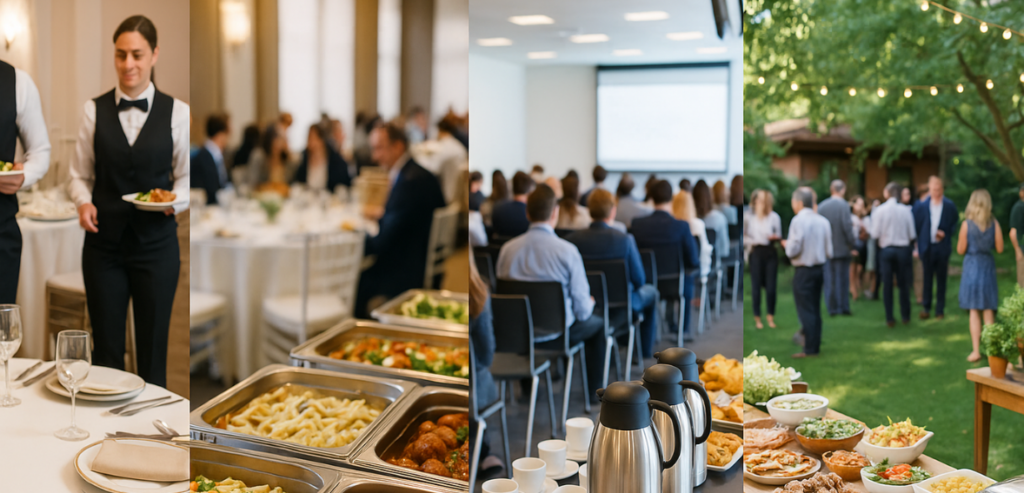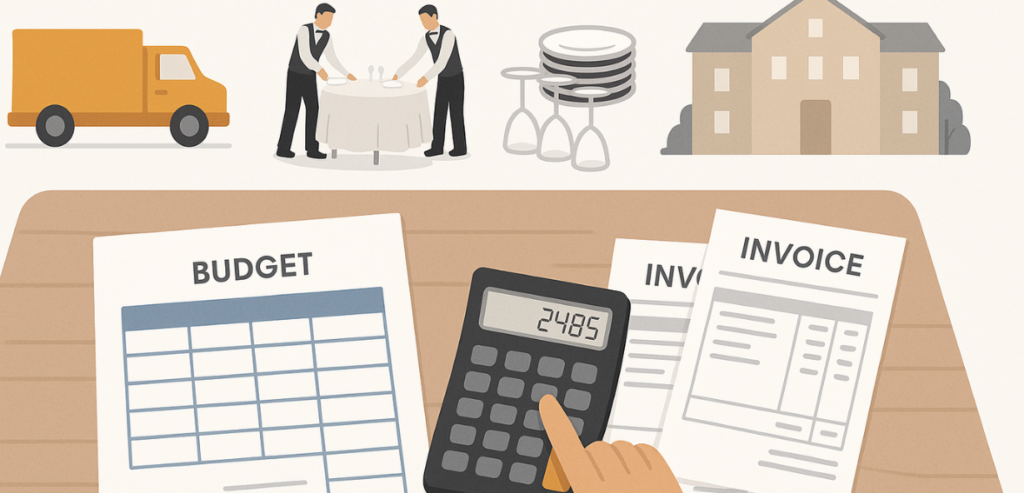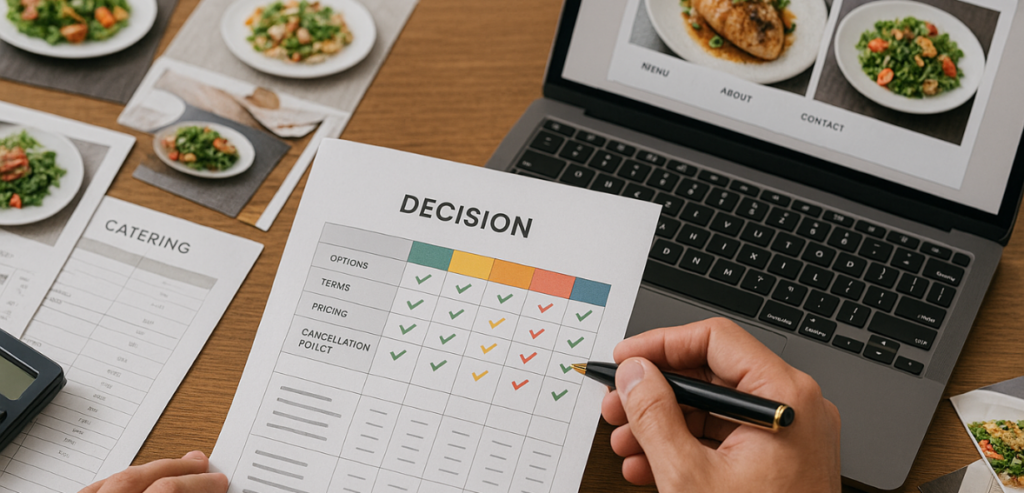Catering Service
The quality of your catering provider will significantly influence the success or failure of your event. Guests often form their opinions about your venue based on the quality of food and service at weddings, corporate functions, and private parties.
By 2025, the catering industry is expected to undergo substantial changes due to evolving trends, technological advancements, and shifting consumer preferences. This comprehensive guide simplifies your search for the perfect catering service provider for your upcoming event.
Understanding Your Event Needs

Event Type and Scale
The type of catering suitable for an event depends largely on its nature. Weddings typically require full-service catering with appetizers, a main course, and dessert. Corporate events may include breakfast buffets, plated lunches, or cocktail receptions. Conferences often need all-day nourishment, while social gatherings may call for either a simple buffet or exclusive food stations.
The number of attendees influences both your catering budget and the best service model. In 2025, many caterers impose service limits, including minimum and maximum guest thresholds. Boutique caterers excel at small, intimate events with fewer than 30 guests, while larger events—those with over 200 attendees—generally require staff-supported caterers with extensive service capacity.
Venue Considerations
Food service options are highly dependent on your event venue. Some venues restrict menu choices, particularly when food must be prepared off-site and transported. Venues equipped with full kitchens allow for more sophisticated food preparation. Catering restrictions, sustainability requirements, and specific cooking bans are often imposed by venues. The room’s size and layout also influence serving methods.
Outdoor venues introduce additional challenges, such as weather contingency plans, power availability, and food safety compliance. Kitchen setup becomes complicated if venues restrict loading zones or limit noise levels. To avoid complications, always review venue policies before engaging your caterer.
Budgeting for Catering Service
Understanding Pricing Structures
Catering prices in 2025 vary based on the service style, menu complexity, staff requirements, venue duration, and geographic location. Buffet-style catering typically costs less than plated service. Prices increase with premium additions and advanced preparation methods, but staff size often plays the largest role in overall cost.
Urban events, especially in East and West Coast cities, tend to cost more than those in the South or Midwest due to higher overheads. Winter weddings are generally more expensive, as this season marks the peak period for such events.
Hidden Costs to Consider

Your catering budget should account for guest meal costs, service fees, gratuities, rental charges, setup and teardown fees, overnight charges, and sustainability expenses.
Rental costs fluctuate based on premium features and custom requests. Some catering companies include late-night breakdown charges or travel expenses for remote events. Rising costs across the industry are also influenced by supply chain adjustments and a growing focus on sustainable sourcing.
Researching Potential Caterers
Finding Reputable Options
Begin with recommendations from peers, industry associations, online reviews, and venue referrals. New catering marketplaces use AI to match caterers with your preferences. Preferred vendor lists often feature pre-vetted caterers familiar with the venue’s logistics. Reputable organizations uphold professional standards and offer verified client feedback.
Venue coordinators can often recommend caterers suited to their specific space. These professionals attend countless events and know which caterers align well with the venue’s unique demands. Top local caterers are often featured in industry publications or recognized by awards such as ACE (Achievement in Catering Excellence).
Evaluation Criteria
When evaluating caterers, inquire about experience with similar events, sustainability initiatives, and crisis management protocols. Local sourcing, waste reduction, and carbon footprint tracking are now standard. Some caterers offer online tastings, live chat support, and specialize in certain cuisines or dietary requirements.
Review their portfolios and social media pages to assess current work and responsiveness to feedback. Always request food safety certifications and health department ratings.
Menu Planning and Food Quality
Current Food Trends
Key catering trends in 2025 include functional foods, plant-forward menus, hyperlocal sourcing, heritage cooking, e-cooking experiences, and micro-seasonal ingredients. Clients increasingly seek healthy and sustainable meals without compromising on taste or creativity.
Chefs now incorporate ancestral produce and traditional techniques to craft modern dishes. Fermentation and preservation methods are used not only to boost flavor but also to reduce waste. Zero-waste menus that utilize entire ingredients—from root to stem or nose to tail—are growing in popularity.
Dietary Accommodations

Modern caterers must skillfully manage allergens, religious dietary restrictions, and child-friendly menus. Dedicated food prep zones in professional kitchens reduce the risk of cross-contamination.
With the rise of special diets, many caterers now offer digital menus that allow filtering by dietary needs. Some even provide QR codes linking to detailed allergen and nutrition information for each dish.
Service Styles and Staffing
Service Options
Catering service styles in 2025 include plated meals for formal events, buffets for casual gatherings, interactive food stations, family-style dining, and cocktail-style passed hors d’oeuvres. Many events now combine styles—e.g., appetizers from stations followed by a plated main course.
Innovative formats include hybrid buffets where staff serve main proteins while guests choose sides—offering a balance of customization and control. Service transitions during events (from stations to seated meals to dessert) are now common.
Staffing Considerations
Standard staffing ratios in 2025 vary: plated service typically requires one server per 8–10 guests, while buffets need one per 25–30. Evaluate the caterer’s training programs and service protocols, as staff professionalism directly impacts the guest experience.
Top-tier catering teams often include section captains, food runners, and guest experience specialists. Ask about staff retention and training frequency to gauge consistency and service quality.
Tastings and Trials

The Modern Tasting Experience
Tastings today may be in-person, exclusive, virtual, or experiential. Group tastings are cost-effective, while exclusive tastings offer more customization, usually priced between $200–$500. Virtual tastings may include mailed sample kits and chef video calls. Full event simulations—with lighting, decor, and real-time pacing—are becoming popular for immersive previews.
What to Evaluate
During tastings, assess temperature, flavor balance, texture, appearance, portion sizes, timing, and adaptability. Food stability is crucial for buffet service. Test how the team responds to last-minute requests or special feedback, as this indicates flexibility and attentiveness.
Logistics and Planning
Timeline Considerations
Catering planning should begin 9–12 months in advance, especially for popular dates. Tasting and menu development typically start 6 months prior. Guest count and menu selection should be finalized 3 months before the event. Floor plans and service details are finalized one month out. Final dietary checks are done two weeks in advance, and a site inspection should occur one week before the event.
For peak wedding seasons or holidays, book caterers at least 2–3 months in advance. Corporate events with flexible menus can sometimes be planned within 4–6 weeks.
Coordination Requirements
Caterers collaborate with venues, planners, entertainers, and rental companies. Venue staff set access rules and layout limitations; rental companies provide furnishings. Caterers work within the event program to time meals and coordinate with entertainment. Seamless collaboration—like synchronized signature cocktails and dessert presentations—enhances guest engagement. Clearly define responsibilities among all vendors to prevent conflicts.
Contracts and Legal Considerations
Standard Contract Elements

Modern catering contracts must include menu specifics, pricing, staff guarantees, setup/teardown timelines, cancellation clauses, insurance requirements, proof of all required food‑service licenses, and sustainability commitments. If you’re unsure which permits apply in your jurisdiction, consult this complete guide to food‑service licenses for a concise refresher before signing.
Include updated force majeure clauses that account for supply chain disruptions, weather issues, or public health crises—changes informed by post-pandemic realities.
Red Flags in Contracts
Watch for vague wording, excessive substitutions, low-ball pricing, unclear overtime policies, or verbal-only agreements. Avoid contracts that allow changes without your approval or demand large non-refundable upfront payments. Payments should be staggered, with the final amount based on guaranteed—not estimated—guest counts.
Technology Integration
Digital Catering Innovations
Top caterers in 2025 utilize augmented reality menus, digital nutrition tracking, production monitoring tools, and real-time feedback systems. Smart inventory systems now help reduce waste and improve ingredient efficiency. Client portals allow for live menu updates and communication throughout the planning phase.
Practical Applications
Technology should enhance—not complicate—the experience. Guest-facing systems must be user-friendly, while staff tools should streamline operations. Tech platforms must integrate smoothly with existing event software. Sometimes, low-tech methods still work best. Ensure backup plans are in place for potential tech issues during the event.
Making the Final Decision

Decision Matrix
Create a decision matrix that weighs food quality (30%), value and service (25% each), flexibility (15%), and sustainability (10%). Rate each caterer on these criteria and apply the weights to calculate overall fit. Use separate matrices for food, service, and planning logistics for a well-rounded evaluation.
Red Flags and Green Lights
Avoid caterers with slow response times, vague pricing, missing insurance, or reluctance to handle dietary needs. Favor those who ask detailed questions, provide clear documentation, and demonstrate staff training and past success. Trust your instincts—smooth communication and alignment on your vision are key to a successful collaboration.
Conclusion
Choosing the right catering service involves careful attention to budget, food quality, service, and sustainability. In 2025, the best caterers offer more than delicious food—they provide complete support, eco-conscious solutions, and smart technology. Do your homework, taste everything, and make your needs clear. Don’t be swayed by the cheapest offer—prioritize the total guest experience. With thoughtful planning, your event will shine, and your partnership with the right caterer will make all the difference.
